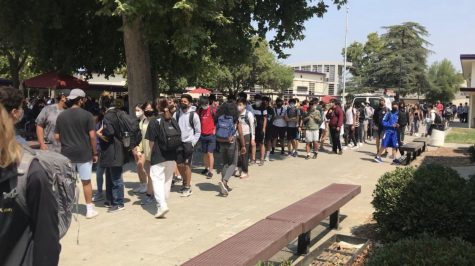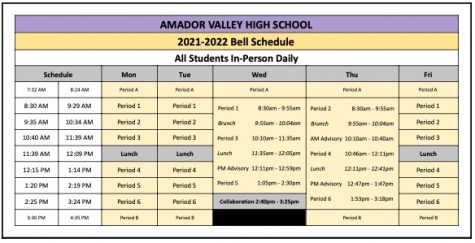By the bell: Amador students and staff reflect on the new schedule
Amador students Joe Dai and Leo Shao pitched their petition and proposals to other business CTE classes on campus.
August 23, 2021
For Joe Dai (‘23), lunch is more of a frantic frenzy than time of leisure. The minute the bell rings, he rushes out to secure a lunch table for him and his friends. As they chat, he keeps an eye on the long lunch line winding from the cafeteria. Once it’s dwindled down to just a few people, he hurries over to grab some food, and scarfs it down quickly, right before his next class starts. This year, he’s decided this routine has to change.
Last week, Dai and partner Leo Shao (‘24) started a school-wide petition to change this year’s new bell schedule. Their primary focus is extending lunch time. The two met in their marketing elective class on campus, and teamed up after discovering they shared a dislike for the short lunch periods.
“What motivated me was that I have people around me that’s been complaining about [the schedule] 24/7, and I just want to help people out,” said Shao.
Having used to live in Germany, where his old school designated one hour to lunch everyday, Dai is still unaccustomed to the thirty-minute lunch time at Amador.
“I barely have time to finish [my lunch] and talk with my friends, which is what lunch is about,” said Dai.
A shorter lunch break wasn’t the only change made to the old schedule. This year’s timetable also took out the nine-minute brunch times on Monday, Tuesday, and Friday, to mixed student reception.

“To be honest, I expected not having brunch to have a huge impact on me, but so far it hasn’t been that bad,” said Victoria Liu (‘23), “I mainly used brunch [in freshman year] to go to the bathroom and catch up on school tests and hang out with friends, [and] I still have been able to do that during lunch and ACCESS.”
Varun Yedavilli (‘23), on the other hand, laments the lack of brunch, since it had been a valuable time for him to recharge and relax.
“Doing two classes is a lot of work for my brain, [because] I can’t last that long on high performance,” said Yedavilli.
One of the more popular adjustments was each school day starting thirty minutes later at 8:30 a.m. This decision resonated with many students, who appreciated the extra half-hour of sleep.
“The change is good — I can wake up a little bit later [and] I can do my homework in the morning if I need to,” said Yedavilli.
The removal of Wednesday late-morning starts, however, has garnered dissent from students, the majority of whom prefer starting school later than ending earlier.
“Getting out at 2:30 p.m. is pretty good, but I do think 9:00 a.m. would be best for a lot of people. People still have things to do, people have buses to catch, people have to get ready, and I think it’s better for people to get more sleep,” said Alex Fernandes (‘25).
A-period students, in particular, were disappointed by the sudden switch. Eric Tandean (‘22), a saxophone player in Wind I, gets to class an hour earlier than other students for band practice. More of a night owl than an early bird, he misses being able to sleep in on Wednesday mornings.
“Just having to consistently wake up early everyday [at 6:30 a.m.] is a little rough for me,” said Tandean.
In previous years, while students were catching extra Zs in bed at home, teachers were at school attending a weekly collaboration meeting. With the elimination of “late Wednesdays,” as dubbed by students, the staff now meet for collaboration in the afternoon after school ends.
For Jonathan Grantham, director of the band program, when teachers meet to collaborate does not greatly impact him, but he sympathizes with students who wish to sleep in like before.
“I am bummed that the students don’t get a late start, [but] I hope the silver lining is maybe getting some time to go home earlier to get things done,” said Grantham.
Now, students are also given more time in school on Wednesdays and Thursdays to study or finish homework. On Wednesdays, students are offered a forty-five minute ACCESS period after lunch, while Thursday’s schedule is slotted with two Advisory periods.

AM Advisory is a thirty-minute long period on Wednesdays, during which students stay in their assigned classrooms to watch AVTV broadcasts and, on some days, complete SEL (Social Emotional Learning) activities organized by the counselors. PM Advisory is a biweekly ACCESS period which lasts for one full hour, wherein students are allowed to move to other teachers’ rooms.
While students grant that having two ACCESS periods may be helpful for those with heavier workloads, most are skeptical that an hour-long ACCESS is necessary. Some also point out that student productivity often isn’t at its peak during school hours.
“For work time, I’m more productive at home than in school and so what ACCESS usually ends up being for me is just a break from school and I can’t get too much work done then,” said Tandean.
One thing to keep in mind is that the school year is barely beginning, so everyone will need time to adjust to the new bell schedule. John Benbenek, English teacher, decided to give the schedule the benefit of the doubt.
“It’s new to have [ACCESS] that long, but one of the things we do as educators is try to find new ways to accommodate student needs, so I’m willing to wait and see how it goes before I make up my mind,” said Benbenek.
With so many revisions to the old schedule, Dai and Shao acknowledge that ensuring complete student satisfaction is near impossible. However, they’re certain there is ample room in the new bell schedule for growth and improvement.
“It really depends on the [California] codes that we have to follow,” said Dai, “Right now we have twenty minutes that we can distribute, because we are currently twenty minutes a week over the required time students need to be in school, so that’s where we’re going to start.”
Principal Butterfield believes feedback like this regarding the new schedule from both students and administrators is paramount towards making sure students can get the most out of the time given, whether it’s in Advisory or class.
“We’re listening to that feedback, [and] we’re really monitoring this. We’re working on setting up a bell schedule committee of staff members to revise and work on this for the upcoming school year to keep reflecting on that,” said Butterfield.









![The outgoing EICs [left to right] Zenil Koovejee, Aileen Hu, Ritika Gupta, Zaynah Shah, and Audrey Combs take a picture with journalism advisor Wendy Connelly to commemorate their last banquet.](https://www.amadorvalleytoday.org/wp-content/uploads/2024/05/458E2D9A--600x451.jpg)








691ad57a-7e8f-4805-977a-c1dde8590373 • Aug 24, 2021 at 10:36 pm
can i be in the newspaper~~
adviser • Sep 10, 2021 at 3:15 pm
Sure- do something positive and amazing and we’ll profile you!